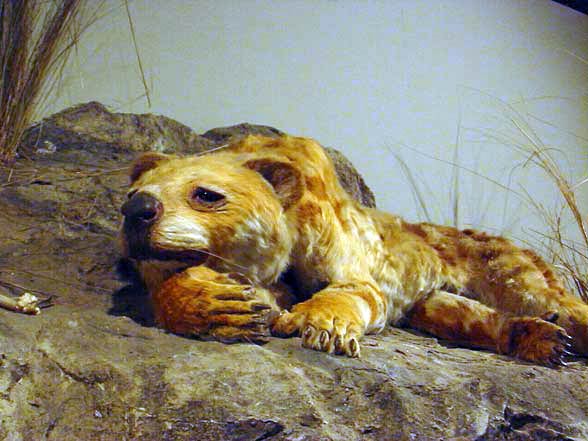

Thylacoleo carnifex, a marsupial lion, is an extinct species of carnivorous marsupial mammal that lived in Australia from the early to the late Pleistocene (1.6 million–46 thousand years ago).[1] Despite its name, it is not closely related to the lion, but is a member of the order Diprotodontia, one of the taxonomic groups of Australian marsupials.
Description
A species of Thylacoleo, it is the largest meat-eating mammal known to have ever existed in Australia, and one of the larger metatherian carnivores of the world (comparable to Thylacosmilus and Borhyaena species, but smaller than Proborhyaenidae). Individuals ranged up to around 75 cm (30 in) high at the shoulder and about 150 cm (59 in) from head to tail. Measurements taken from a number of specimens show they averaged 101 to 130 kg (223 to 287 lb) in weight, although individuals as large as 124–160 kg (273–353 lb) might not have been uncommon, and the largest weight was of 128–164 kg (282–362 lb).[2] This would make it comparable to female lions and female tigers in general size.
The animal was extremely robust with powerfully built jaws and very strong forelimbs. It possessed retractable claws, a unique trait among marsupials. This would have allowed the claws to remain sharp by protecting them from being worn down on hard surfaces. The claws were well-suited to securing prey and for climbing trees. The first digits (“thumbs”) on each hand were semi-opposable and bore an enlarged claw. Palaeontologists believe this would have been used to grapple its intended prey, as well as providing it with a sure footing on tree trunks and branches. The hind feet had four functional toes, the first digit being much reduced in size, but possessing a roughened pad similar to that of possums, which may have assisted with climbing. The discovery in 2005 of a specimen which included complete hind feet provided evidence that the marsupial lion exhibited syndactyly (fused second and third toes) like other diprotodonts.[3]
The species hindquarters were also well-developed, although to a lesser extent than the front of the animal. Remains of the animal show it had a relatively thick and strong tail and the vertebrae possessed chevrons on their undersides where the tail would have contacted the ground. These would have served to protect critical elements such as nerves and blood vessels if the animal used its tail to support itself when on its hind legs, much like present day kangaroos do. Taking this stance would free up its fore limbs to tackle or slash at its intended victim.[4] The discovery of complete skeletons preserving both the tail and clavicles (collarbones) in Australia’s Komatsu Cave in the town of Naracoorte and Flight Star Cave in the Nullarbor Plain, indicate the marsupial lion had a thick, stiff tail that comprised half the spinal column’s length. The tail may have been used in novel behaviors not seen in other marsupials, and was probably held aloft continuously. The discovery of the clavicle indicates that the marsupial lion may have had a similar type of locomotion to the modern Tasmanian devil.
Evolutionary relationships
The ancestors of thylacoleonids are believed to have been herbivores, something unusual for carnivores. Cranial features and arboreal characteristics suggest that thylacoleonids share a common ancestor with wombats.[6] While other continents were sharing many of their predators amongst themselves, as they were connected by land, Australia’s isolation caused many of its normally docile herbivorous species to turn carnivorous.[7] Possum-like features were once thought to indicate that the marsupial lion’s evolutionary path was from a phalangeriform ancestor, however, scientists agree that more prominent features suggest a vombatiform ancestry. However, the recently discovered Microleo is a possum-like animal.
The marsupial lion’s limb proportions and muscle mass distribution indicate that, although it was a powerful animal, it was not a particularly fast runner. Paleontologists conjecture that it was an ambush predator, either sneaking up and then leaping upon its prey, or dropping down on it from overhanging tree branches (a behaviour that may have been preserved in tribal memory and been the original inspiration for the fictional animal the drop bear, per a BBC documentary series[13]). This is consistent with the depictions of the animal as striped: camouflage of that kind is needed for stalking and hiding in a largely forested habitat (like tigers) rather than chasing across open spaces (like lions).[14] Trace fossils in the form of claw marks and bones from caves in Western Australia analyzed by Gavin Prideaux et al. indicate marsupial lions could also climb rock faces, and likely reared their young in such caves as a way of protecting them from potential predators.[15] It is thought to have hunted large animals such as the enormous Diprotodon and giant browsing kangaroos like Sthenurus and Procoptodon, and competed with other predatory animals such as the giant monitor lizard, megalania, and terrestrial crocodiles such as Quinkana. The marsupial lion may have cached kills in trees in a manner similar to the modern leopard.[16] Like many predators, it was probably also an opportunistic scavenger, feeding on carrion and driving off less powerful predators from their kills. It also may have shared behaviours exhibited by recent diprotodont marsupials such as kangaroos, like digging shallow holes under trees to reduce body temperature during the day.
